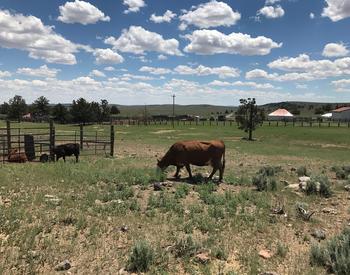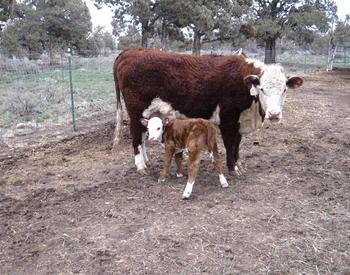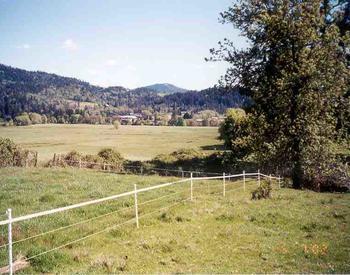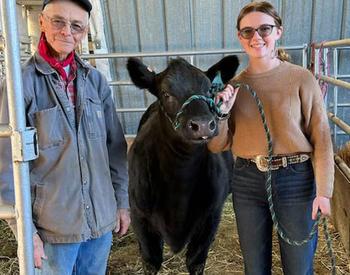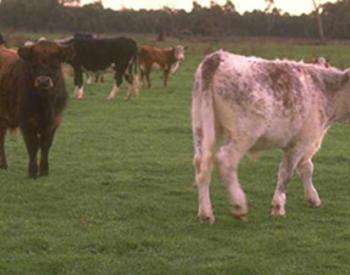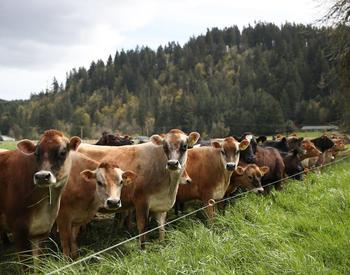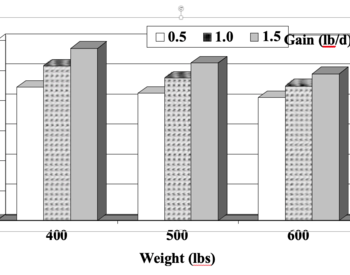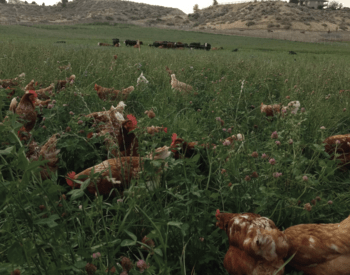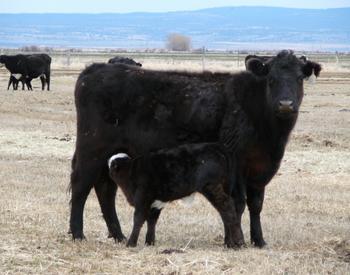Good nutritional status is one of the most important factors in successful reproduction. In this article I will review the nutritional demands, the nutrient requirements, and the nutrient content of common feeds for mature cows and first-calf heifers after calving and into the breeding season.
Challenges
It is especially challenging to meet nutritional needs during this post-partum period. Compared to other times in the cow’s production cycle, cows have the highest energy and protein requirement in this phase. The cow is facing several tasks. She is recovering from calving with the repair and involution of the uterus to its pre-pregnant state, the development of follicles, and release of a viable egg from the ovary. She is also nursing a calf. And if she is a young cow, she requires extra nutrients for her continued growth. A good goal is to have first-calf heifers at 85% of their mature weight at calving.
This is also the time of year when extra nutrients are required to maintain body heat in cold weather. Wow, that is a lot to ask of our cows! However, if we do this right, they will conceive in a timely manner (to calve early next year) while successfully weaning their current calf.
It is difficult for cows to consume enough energy and protein to support all the demands in the post-partum period, and they are typically in negative energy balance (more energy expended than taken in). Fortunately the body can store energy to help with these demands.
A common way to assess body energy reserves is the body condition score (BCS) system. Scores range from 1 (extremely emaciated) to 9 (obese).
Build BCS prior to calving. Cows calving in BCS 5 and heifers calving in BCS 6 are in optimal condition and perform better than those in lower BCS. That is, they return to estrus sooner, have improved pregnancy rates, and conceive earlier in the breeding season. I urge you to use this system if you are not already doing so.
The reproductive system of the cow takes cues from the internal and external environment. The BCS and diet of the cow are two of the factors the body "evaluates" prior to resuming reproductive functions. An increasing plane of nutrition provides positive signals. If you have your cows in good body condition at calving, you can more easily feed your cows for reproductive success.
Feeding Tips
Let's look at specific protein (crude protein, CP) and energy (total digestible nutrients, TDN) needs and feed quality. Daily requirements of cows during early lactation (moderate milking ability, 10 lbs) for dry matter (DM, as fed feed minus the water), CP, and TDN along with some feed values are listed in the Table 1 below.
| Item 3 | DMI Lb | CP Lb | CP % | TDN Lb | TDN % |
|---|---|---|---|---|---|
| 1100 lb Mature Cow | 20.2 | 2 | 9.6 | 11.5 | 56.6 |
| 900 lb First-Calf Heifer | 19.2 | 2 | 10.4 | 12 | 62.7 |
| Grass Hay, average quality | 7 | 57 | |||
| Alfalfa Hay, fair quality | 17 | 57 | |||
| Ground barley | 12 | 87 |
As you can see, animal requirements and nutrient content of feeds vary. Separate rations using different combinations of feeds are needed in order to provide feed economically and support production goals.
Animal nutrient requirements can be found in publications, but hay quality is unique to each specific harvest and should be tested. Pasture and rangeland forage vary with stage of plant maturity, but generally are of sufficient quality during the spring breeding season to meet requirements if sufficient quantity is available.
Balancing rations for livestock takes some level of skill and knowledge but can be learned and practiced with little difficulty. You can hire a nutritional consultant or seek help from OSU Extension Service. OSU Winter Nutrition Programs are planned for presentation in your area. Attend one of these programs to learn more about this important topic.
Using information from Table 1, an example diet for the mature cows would be about 18 lb of grass hay and 6 lb of alfalfa per head per day on an as fed basis. For the heifers, 12.5 lb of grass hay, 5.5 lb of alfalfa, and 3.5 lb of barley would satisfy requirements. The rations are quite different between the two classes of cows. Remember to have plenty of clean, fresh water for your livestock. An adequate amount of good water promotes feed intake and milk production. You should also provide cows with a custom mineral and vitamin mix. Track intake of this supplement to make sure they are consuming the right amount.
Many producers test their hay and find they save money by knowing how much of each commodity to feed. Overfeeding wastes costly resources. Underfeeding causes low pregnancy rates and delayed conception dates, both of which can decrease the pounds of saleable calf at weaning time. Test your hay so you can use the information to balance your livestock rations to meet production goals in an economic manner.
